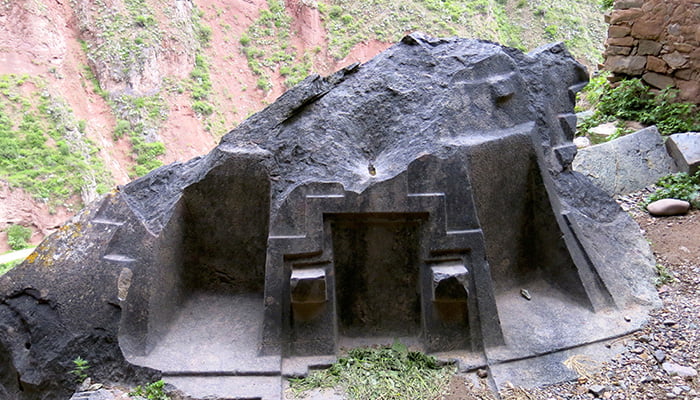
The Sacred Valley of the Incas near Cusco is full of wonderful archaeological treasures and beautiful scenery for those who are willing to get a bit off the beaten track. One of the most interesting and special of these hidden […]

The Sacred Valley of the Incas near Cusco is full of wonderful archaeological treasures and beautiful scenery for those who are willing to get a bit off the beaten track. One of the most interesting and special of these hidden gems is the impressive carved-stone temple known as Ñaupa Iglesia, whose name roughly translate to “old church” in a mixture of Quechua and Spanish.
The small, enigmatic site of Ñaupa Iglesia is generally considered to have been a “huaca,” the Quechua word for a place, person or object that is endowed with sacred significance. It was likely a node on the Inca ceque system, a series of ritual pathways radiating out from Cusco along which were placed huacas and other important shrines. Pilgrims and other travelers would have traveled along these lines while fulfilling certain ritual obligations. Though the exact way in which huacas were thought of and used by the people of the time is largely unknown, visiting a place like Ñaupa Iglesia gives visitors a small glimpse into the mysteries of the Inca worldview.
Located along a trail just outside of Ollantaytambo near the district of Pachar, a visit to Ñaupa Iglesia makes for a great half day excursion while in the Sacred Valley. You won’t find many other tourists on this side excursion, and that’s one of its biggest draws. Spend some time hiking to this hidden wonder and you’ll feel yourself transported to a totally different era, the age of the Inca Empire.
To get to Naupa Iglesia, you’ll need to climb up past a series of terraces, much like the ones that can be found at many other important Inca archaeological sites. Once you arrive to the top, you will find a large cave that has been transformed into a temple. One wall contains carved “window” niches while the wall opposite it has a carved “door” niche, none of which lead anywhere. This has lead to speculation that the site was meant to symbolize a sort of portal to a different realm in Inca cosmology. In the middle of the cave’s opening is a large stone that has also been carved with three niches as well as a chakana (“Inka cross”) symbol.
The construction of Ñaupa Iglesia was likely influenced by astronomical alignment in one way or another, much like other important Inca shrines. The famous Intihuatana stone at Machu Picchu is another example of the Incan dedication to observing the sky. Many historians believe that the original name of this site was choquekilla (“golden moon”), which would seem to make reference to some sort of astronomical significance for the shrine. As you explore this sacred cave, let your mind wander a bit and try to imagine what this mysterious place may have been like during the time of the Inca Empire.
Ñaupa Iglesia is one of Cusco’s least-visited archaeological sites, but this mystical and beautiful Inca temple is well worth visiting while in the Sacred Valley. Consider making a detour in order to visit this superb off-the-beaten-track ruin. When you’re ready to head back after visiting the serene temple of Ñaupa Iglesia, make sure to stop for a beer at one of Peru’s best craft breweries, the Cerveceria del Valle Sagrado, whose brewpub is located near the trailhead for Ñaupa Iglesia. A little bit of archaeological exploration and a refreshing beer afterwards makes for a wonderful way to spend an afternoon in Peru’s Sacred Valley!
Header Image: Modified from Flickr / Emily Meier

Discover our latest blogs

Personalized tours to Machu Picchu and other iconic destinations, handcrafted by passionate local experts.
2025 Cusco Native Tours. All rights reserved.